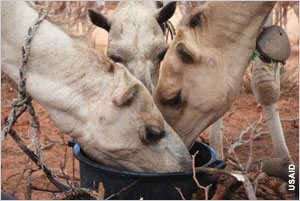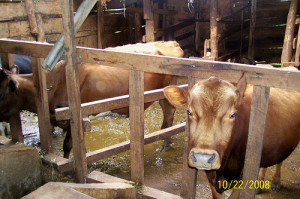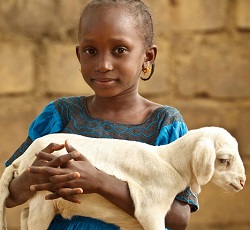 During the holiday gift-giving season, a popular choice for gift donations are programs that send live farm animal gifts to help alleviate hunger and poverty in low-income countries.
During the holiday gift-giving season, a popular choice for gift donations are programs that send live farm animal gifts to help alleviate hunger and poverty in low-income countries.
Our purpose here is to make the criticisms of these campaigns public and to encourage alternatives that are more effective and more compassionate.
We examine the flaws in concept and practice with animal-gifting groups in general, and with Heifer International in particular (since they are well-known and extremely large).
In short, we explain why animal gifting doesn’t necessarily help, and sometimes harms, the recipients, and how these programs may be misleading to donors.
Specifically, the sections below provide details about these concerns…
-
jump to – Most recipients are lactose intolerant and harmed by dairy
-
jump to – More farmed animals does not equate to less hunger
-
jump to – More farmed animals mean more mouths to feed
-
jump to – Farmed animals do not just “live off the land”
-
jump to – Farmed animals use a great deal of water
-
jump to – Experts disapprove of animal gifting
-
jump to – Animal gifting programs are misleading
-
jump to – Animal gifting programs have questionable spending
-
jump to – Animal gifting programs raise concerns with charity-raters
-
jump to – There are better gift-donation programs to feed people in need
1. Most recipients are lactose intolerant and harmed by dairy…
 Increased dairy production is frequently touted as one of the greatest successes of animal gifting programs.
Increased dairy production is frequently touted as one of the greatest successes of animal gifting programs.
However, 75% of the world is lactose-intolerant, and 90% of Asian and African populations (toward whom dairy programs are aggressively targeted) are lactose intolerant.
As such, both small- and large-scale dairy programs negatively affect the health, well-being, and productivity of people in lactose intolerant populations.
Additionally, dairy production negatively impacts local communities with ripple effect consequences that ultimately disadvantage entire societies.
Lactose intolerance occurs when there is not enough of an enzyme called lactase. Because of this, raw milkstill poses problems.
The result is widespread digestive ills such as stomach pain, gas, bloating, cramps, diarrhea, and even vomiting. Consuming milk from other animals is also associated with allergies, asthma, and a host of autoimmune disorders.
Most mammals (including humans) become lactose intolerant after weaning. Milk is very specifically created for infants of ones own species, not adults of any species.
There is also no need for humans to consume the milk of other animals. Logically, this makes sense, but rarely is it fully considered.
While dairy is “a” source of calories and protein, the resources used to produce it may be better spent on alternatives that provide a higher quality and quantity of calories, protein and calcium.
*****************
 Animal-giving programs seem to focus on small-scale farming, but they have extremely large-scale implications that pave the way for factory farming and exponentially increase consumption of meat, dairy and eggs throughout entire countries and beyond.
Animal-giving programs seem to focus on small-scale farming, but they have extremely large-scale implications that pave the way for factory farming and exponentially increase consumption of meat, dairy and eggs throughout entire countries and beyond.
Heifer International is largely considered responsible for kick-off of industrialized dairy in Japan after World War II. Heifer International boasts that their projects produced 3.6 million gallons of milk in one year in Uganda and developed a national dairy program in Tanzania.
Tanzania.
These massive programs were developed despite the high prevalence of lactose intolerance in these regions (more than 90% of the population in some Asian and African countries) and despite the fact that native plant crops are capable of producing equal or greater amounts of protein, calcium and other nutrients.
2. More farmed animals does not equate to less hunger…
 Pro-meat biases mean that sustainable plant crops that actually provide better nutrition and more income are often overlooked.
Pro-meat biases mean that sustainable plant crops that actually provide better nutrition and more income are often overlooked.
Teff, for example, is one of Ethiopia’s oldest grains. It is drought and heat tolerant, while also being packed with protein and calcium.
In Food Choice and Sustainability (2013), Dr. Richard Oppenlander writes:
“In Ethiopia, over 40 percent of the population is considered hungry or starving, yet the country has 50 million cattle (one of the largest herds in the world), as well as almost 50 million sheep and goats, and 35 million chickens, unnecessarily consuming the food, land and water… [P]oorly managed cattle grazing has caused severe overgrazing, deforestation, and then subsequent erosion and eventual desertification. Much of their resource use must be focused on these cattle.
Instead of using their food, water, topsoil, and massive amounts of land and energy to raise livestock, Ethiopia, for instance, could grow teff, an ancient and quite nutritious grain grown in that country for the past 20,000 to 30,000 years.
Teff…is high in protein, with an excellent amino acid profile, is high in fiber and calcium, (1 cup of teff provides more calcium than a cup of milk), and is a rich source of boron, copper, phosphorus, zinc, and iron.
Seventy percent of all Ethiopia’s cattle are raised pastorally in the highlands of their country, where less than 100 pounds of meat and a few gallons of milk are produced per acre of land used.
Researchers have found that teff can be grown in those same areas by the same farmers at a yield of 2,000 to 3,000 pounds per acre, with more sustainable growing techniques employed and no water irrigation— teff has been shown to grow well in water-stressed areas and it is pest resistant.”
Tanzania.
These massive programs were developed despite the high prevalence of lactose intolerance in these regions (more than 90% of the population in some Asian and African countries) and despite the fact that native plant crops are capable of producing equal or greater amounts of protein, calcium and other nutrients.
3. More farmed animals mean more mouths to feed…
 Many recipients of animal gifting programs struggle to provide even the most basic care to the animals they receive.
Many recipients of animal gifting programs struggle to provide even the most basic care to the animals they receive.
Animals do not magically produce milk and meat or just “live off the land” by grazing (details below). Animals must be provided food and water in areas where these resources are already scarce.
Having another mouth to feed can significantly add to afamily’s burden, and the animals frequently suffer from neglect, malnutrition, dehydration, lack of veterinary care, and lack of shelter from temperature extremes.
4. Farmed animals do not just “live off the land”…
 While tempting to believe, farmed animals do not just “live off the land” consuming only grass and scraps that don’t compete with human consumption.
While tempting to believe, farmed animals do not just “live off the land” consuming only grass and scraps that don’t compete with human consumption.
In response to criticism that promoting animal agriculture in regions already plagued by desertification and drought is irresponsible, Heifer International and other organizations have “zero-grazing” requirements.
Unfortunately, zero-grazing means that confined animals must actually have food and water brought to them. This food and water can be in direct competition with human consumption.
Zero-grazing is not only bad for the animals who are confined, it is also bad for the people (often times bad for children) who must use their time, labor and resources to bring food and water to the animals. (Photo: creative commons flickr user treesftf.)
5. Farmed animals use a great deal of water…
 Raising animals requires up to 10 times more waterthan growing crops for direct consumption.
Raising animals requires up to 10 times more waterthan growing crops for direct consumption.
Yet, organizations such as Heifer International promote inherently water-intensive animal farming, even in areas identified as water-scarce.
This means that already limited freshwater suppliesare diverted to animals for their hydration, sanitation, and the cultivation of the forage used to feed them.
These uses of water are in direct competition with the drinking water needs of local communities, as well as with the supply of water available to grow foods for direct human consumption.
Additionally, in many arid communities, water is only available from a communal well or reservoir, in which case hydrating animals is a labor-intensive process for adults and children who must travel by foot and can only carry so much.
 Photo: Drip irrigation project in Kenya
Photo: Drip irrigation project in Kenya
Initiatives such as micro-irrigation (or drip irrigation) projects for growing crops are far more sustainable and ecologically sound, and have helped provide an alternative livelihood to many pastoralists and subsistence farmers.
With micro-irrigation, crops can be grown year round, supplying families with sources of food as well as income from surplus harvest.
Families who have lost farmed animals to drought are now growing crops and experiencing food security, better nutrition, and access to healthcare and education as a result of a steady income.
6. Experts disapprove of animal gifting…
 The World Land Trust calls animal gifting programs “madness… environmentally unsound and economically disastrous…”
The World Land Trust calls animal gifting programs “madness… environmentally unsound and economically disastrous…”
They conclude that “now that the grave consequences of introducing large numbers of goats and other domestic animals into fragile, arid environments is well documented, WLT considers it grossly irresponsible… to continue with these schemes … as a means of raising quick money for charities over the Christmas season.”
Sean O’Neill of the Times of London explains that animal gifting organizations “are wooing the ethical shopper with pictures of cute goats wearing Christmas hats and promises of helping the poor in developing countries.”
But organizations such as the World Land Trust and Animal Aid deem that “it is ‘madness’ to send goats, cows and chickens to areas where they will add to the problems of drought and desertification.”
Former Indian minister for social welfare and animal protection, Maneka Gandhi explains that when goats are allowed or forced by consequences to graze: “each goat eats all the grass and shrubbery on two hectares of land a year. A goat destroys the fertility of land and [the value of] any milk or dung it may give is very little compared to the havoc it wreaks……within two years, the people who get goats have an even
poorer lifestyle.
There are village quarrels about community grazing; children are taken out of school to graze the goats; water becomes even scarcer……Two goats can reduce the amount of farmland available to local people and result in villages becoming deserted, while a cow will drink up to 90 liters of water every single day.”
Farm animal gifts
The OpEd news article continues: “Some agricultural economists began pointing out flaws in the strategy during the 1970s, notably that manyrecipients of gift animals were unable to feed them to maturity, let alone able to feed and raise offspring.”
“Environmentalists later added questions about the wisdom of introducing non-native livestock to often fragile habitats, where animals with larger or different appetites from the indigenous strains might overtax the vegetation or simply starve.”
7. Animal gifting programs mislead the public…
 Heifer International and similar organizations spend exorbitant amounts of money on colorful, glossy catalogs depicting cute children hugging and kissing healthy, happy animals (like this HI photo).
Heifer International and similar organizations spend exorbitant amounts of money on colorful, glossy catalogs depicting cute children hugging and kissing healthy, happy animals (like this HI photo).
From these catalogs, donors choose which animal they would like to send as their gift-donation.
But in reality, donations may not go toward the purchase of the selected animal. Quoting from Heifer International’s website, “monies from any… animal fund can be used where needed most.”
Vegetarians and vegans beware: bee and tree gift-donations can support any animal program, fundraising, or overhead.
Furthermore, children who are supposed to benefit from animal gifts may be taken out of school to tend to animals. Some children have even had to sleep in the barn with animals to prevent theft. Ultimately, most of their animal “friends” will suffer painful deaths due to disease, deprivation, or slaughter. (Photo above: from Heifer International website.)
 And finally, the animals are far from happy. Many gifted animals suffer from confinement, neglect, malnutrition, and lack of protection from weather and temperature extremes.
And finally, the animals are far from happy. Many gifted animals suffer from confinement, neglect, malnutrition, and lack of protection from weather and temperature extremes.
Animals also endure horrific slaughter processes and long distance transport to and from the recipient’s location.
According to Animal Nepal Founder, Lucia DeVries:
“I have been sending letters to Dutch agencies to stop this kind of program for yet another reason… the animals are generally slaughtered in an inhumane manner…
…In Nepal, for instance, there is only one slaughterhouse, in the capital (Katmandu). This means that virtually all livestock are killed with the often not-too-sharp-knife of rural butchers, causing much suffering to the animal and possibly to the butcher. I’ve met quite a few people who lost fingers while trying to kill a goat.”
*Note: slaughter photo not shown due to graphic nature.
8. Animal gifting orgs may have questionable spending…
 Concerns about the priorities and appropriate use of donations apply to all animal gifting programs, but Heifer International raises particular concerns because of their annual budget which exceeds $250 million a year*, and luxury spending such as on their headquarters pictured here.
Concerns about the priorities and appropriate use of donations apply to all animal gifting programs, but Heifer International raises particular concerns because of their annual budget which exceeds $250 million a year*, and luxury spending such as on their headquarters pictured here.
HI spends more than 2.4 million dollars a year on professional fundraising fees.
Those are just the “fees.” The figure jumps to more than $23 million when printing, distribution, processing, and other fundraising-related costs are included.
According to Heifer International’s 2014 taxes, they spent $23,269,810 on fundraising alone. (more 990s)
*Be watchful as Heifer International is divided into two organizations for tax purposes. Heifer Project International is their main organization. Heifer International Foundation is smaller. For the most accurate numbers, the two should be added, thus further elevating their income and expenses.
So, where is YOUR donation really going? Is your donation paying for fancy buildings, the CEO’s $313,008 salary, plus ($33,429) benefit package, or expensive glossy catalogs that are shipped to tens of thousands of people who don’t even request them?
As explained in the earlier section, any donation can be used “where needed most.” This includes Heifer International’s massive fundraising budget.
*********
Former Indian minister for social welfare and animal protection, Maneka Gandhi, stated:
“Nothing irritates me more than charities abroad that collect money and purport to give it to women or children or for animals in Asia or Africa. Very little reaches the country or the cause for which it is meant. Most of it goes toward their own ‘infrastructure,’ which means rent, staff, travel and ‘investigation’… This is cynical exploitation of animals and poor people.”
9. Some animal gifting programs raise concerns from charity raters…
 GiveWell charity rating organization deemed in their evaluation of Heifer International that the organization lacked sufficient transparency and priority programming to secure GiveWell recommendations or funding.
GiveWell charity rating organization deemed in their evaluation of Heifer International that the organization lacked sufficient transparency and priority programming to secure GiveWell recommendations or funding.
Quoted from the GiveWell website are concerns about animal gifting in general:
“When examining organizations implementing livestock-distribution programs, we feel it is appropriate to ask the following questions. We have not found a livestock-distribution charity that has published either evidence of impact… or clear answers to these questions.
- Are the livestock in good health? Will they meet recipients’ expectations, or will they die or underproduce, potentially causing people to make bad plans and investments?
- Do the recipients of livestock gifts have the ability, in terms of knowledge and resources, to take care of the livestock well? (Similar problems as in the above bullet point could arise if they don’t.)
- Do the recipients of livestock intend to take care of the livestock well? Or is there reason to be concerned that gifts of livestock could lead to cruelty to animals?
Are gifts successfully targeting those in need within a community? Is there a risk of fostering jealousy and/or economic instability?
-
Are there other consequences of introducing large numbers of livestock into a community?
-
Might recipients benefit more from different valuable gifts, such as cash?”
10. There are better feeding & gift-donation programs…
 Due to popular demand, we created a special Plants-4-Hunger gift-giving program to provide a compassionate and highly effective alternative.
Due to popular demand, we created a special Plants-4-Hunger gift-giving program to provide a compassionate and highly effective alternative.
We send 100% of your donation to four hand-picked groups with low overhead and proven successes in high-need areas. These hunger relief projects provide both immediate assistance and long-term community solutions that feed some of the world’s most deprived children without harming animals.
We make it easy with one tax-letter, personalize gift-card and our inspiring information booklet, but you may also choose to give directly to these groups or choose from our grants list.
Source: A Well-Fed World
815 Otis Place NW, Washington, DC (202)4951348 care@awfw.org
A Well-Fed World is a hunger relief and animal protection organization chipping away at two of the world’s most immense, unnecessary and unconscionable forms of suffering… the suffering of people hungry from lack of food, and the suffering of animals used and abused for food.
 TheBulletin.ca Journal of Downtown Toronto
TheBulletin.ca Journal of Downtown Toronto